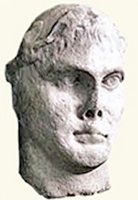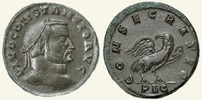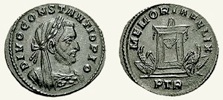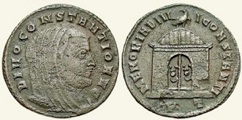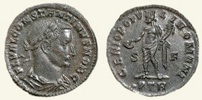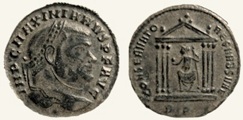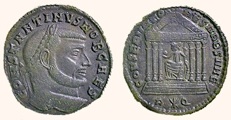Marble bust (4th century AD with imperial oak wreath
Probably Emperor Constantine
York Museum
Acclamation of Constantine (306 AD)
According to the ‘Origo Constantini Imperatoris’ (as discussed on the previous page):
-
“... Constantius, after winning a victory over the Picts, died at York, and Constantine was unanimously hailed as Caesar by all the troops” (2:4).
Zosimus (who was following an account by Eunapius ) also gave a similar account:
-
“It happened that Constantius died at that time; the guards, therefore, who thought none of his legitimate children to be fit for the imperial dignity, considered that Constantine was a person capable of sustaining it, and conferred the honour upon him in hopes of being remunerated with handsome presents” (‘Historia Nova’, 2:9).
The so-called ‘Chronography of 354 AD’ gives the date: the entry under 25th July records the anniversary of the natales imperii of (the by-then deified) divus Constantinus.
Whether or not the soldiers knew or cared whether Constantine had been born in wedlock is surely beside the point: their judgement that he was more credible as the successor to his father than any of his half-brothers was not unreasonable:
-
✴Constantine had been fighting with them in the wilds of Caledonia during the previous winter, and we must assume that they been impressed by his performance; and
-
✴the oldest of these siblings could not have been much more than 15 years old.
Thus, Constantine returned to Gaul as his father’s successor, albeit that he had yet to receive ratification of his position from the new senior Augustus, Galerius (as discussed below). We can reasonably assume that the people of Gaul readily accepted their new ruler.: an idea of the prestige attached to a resident imperial presence there can be had from a panegyric (Panegyric X, translated into English in Nixon and Rodgers, referenced below) that had been delivered in Trier in 289 AD, when Maximian had been resident there:
-
“... we beseech you [Rome] ... that you not be jealous of this city [Trier], upon which [Maximian] now confers a majesty similar to your own by celebrating your birthday [here]” (14: 3).
This imperial presence in Gaul had remained under Maximian himself and then (after 293 AD) under Constantius: the people there would have surely relished a third imperial resident, now that Constantius was dead. However, we may reasonably assume that Constantine sought to reinforce his popularity and to underline his filial piety by the public celebration of his father’s memory.
Deification of Constantius
Constantine for DIVO CONSTANTIO AUG: Constantine for DIVO CONSTANTIO PIO:
CONSECRATIO MEMORIA FELIX
RIC VI Lyon 202 RIC VI Trier 789
There is no doubt that Constantius was deified after his death:
-
✴Eutropius was explicit:
-
“... [the newly-deceased Constantius] was enrolled among the gods” (Breviarium historiae Romanae, 10:1).
-
✴Two passages in a panegyric (Panegyric VII, translated by Nixon and Rodgers, referenced below) that was delivered at Constantine’s new court at Trier in the year after Constantius’ death, were similarly so:
-
“... the deified Constantius ... has been transported to the councils of the gods ...” (3:3).
-
“Divine Constantius, ... you whom the sun himself took up on a chariot almost visible, to carry you to Heaven ... ” (14:3).
There is also ample evidence from the coins that Constantine issued for divus Constantius at this time, which are described in the page on Consecrated Tetrarchs (306-11 AD).
There is scant evidence relating to the circumstances of Constantius’ formal deification. However, we can again make use of the precedent of Septimius Severus: after his ashes had been interred in the mausoleum of Hadrian (above), his effigy had been burned in a multi-storey pyre, from which an eagle had been released to symbolise his apotheosis. This pyre was depicted on consecration coins, some of which had the legend ‘CONSECRATIO S C’ to indicate that the Senate had ratified Severus’ deification. (A version with the shorter reverse legend ‘CONSECRATIO’ is illustrated by the British Museum). Constantine produced a similar coin for divus Constantius at Trier although obviously without the S C designation. The most likely scenario is that this coin commemorated a formal ceremony, probably at Trier, at which Constantine had officiated following his father’s funeral.
In unilaterally deifying Constantius, Constantine was (perhaps consciously) following the example of the deification of the ‘Gallic Emperor’ Victorinus (discussed in the page on the Gallic Empire (260-74 AD). As David Sear (referenced below) observed (at p 394):
-
“Of all the Gallic emperors, Victorinus alone was accorded deification and a posthumous coinage in his honour . As he was the only one to be succeeded by a close relative [Tetricus I], this should occasion little surprise.”
In fact, there is no hard evidence that Tetricus had been related to Victorinus. Nevertheless, the point stands: Victoria, Victorinus’ mother, who was apparently powerful enough to arrange for Tetricus’ acclamation, had probably also arranged for the deification of Victorinus. The deification of a ‘usurper’ would clearly not have been ratified by the Senate in Rome, but this had not precluded his deification in Gaul.
Burial of Constantius
What little we know of the burial of Constantius is contained in Photius’ epitome of Philistorgius’ “Eccelsiastical History” (i.e. a 9th century summary of a now-lost history that had been written in ca. 425 AD):
-
“Constantine, ... committed [Constantius’] body to the tomb soon after [his death], and was shortly [thereafter] proclaimed his successor in the Empire”.
Mark Johnson (referenced below, 1992), who searched for other evidence, reluctantly concluded that:
-
“Beyond the fact that [Constantius] was honourably buried and [deified - see below], nothing is certain. It would seem most likely that he was buried near one of his residences, perhaps at York but, more probably, near his principal residence at Trier”.
(See also the entry in Mark Johnson’s book of 2009, referenced below, in Appendix B, p 207).
We might be able to throw some light on the matter by examining the precedent provided by the burial of an earlier Emperor who had died at York: Septimius Severus had died there in 211 AD and, in this case, the details were recorded by Cassius Dio and Herodian (as described in the page on the Five Emperors and Severans (193 - 235 AD)). Thus, we know that:
-
✴Severus’ sons, Caracalla and Geta, who were with him when he died, arranged a ceremony at York in which he was cremated;
-
✴his ashes were placed in an urn (of purple stone, according to Cassius Dio; or of alabaster, according to Herodiian) and taken by his sons to Rome; and
-
✴the Senate came out to meet them and escorted the urn to the mausoleum of Hadrian, where it was interred.
This precedent suggests that Constantius’ remains were probably not left in Britain. However, given the political circumstances, neither were they likely to have been taken to Rome. As Mark Johnson suggested, Trier was their most likely destination. Although cremation had largely given way to inhumation by this time, it is possible that Severan precedent was followed in this respect because of the need to transport the remains.
We can now consider how the presumed ashes of Constantius would have been housed. Mark Johnson (referenced below, 2009, at p 58), pointed out how burial practices had changed since the time of Severus:
-
“Unlike the earlier practice, in which most Emperors were buried in the ‘extra-dynastic’ mausolea of Augustus [or] of Hadrian [in Rome], [each] of the first Tetrarchs had an individual [mausoleum], shared or meant to be shared with a spouse or close family member, usually located near one of his residences.”
In fact, this was certainly or probably the case for three of the first Tetrarchs:
-
✴Diocletian (who was almost certainly buried in the mausoleum that he had built next to his retirement palace at Salonica, modern Split, in Croatia);
-
✴Maximian (who had almost certainly built a mausoleum next to his palace in Milan and who might have eventually been buried in it); and
-
✴Galerius (who was almost certainly buried in the mausoleum that he had built near his planned retirement palace at Romuliana, modern Gamzigrad, in Serbia).
However, (as Mark Johnson recognised) the situation regarding their colleague Constantius is unknown. Given the Tetrarchic precedents, it seems highly likely that he had built a mausoleum near one of his residences, presumably that at Trier, albeit that no record of it survives. If so, Constantine would surely have placed his father’s remains in this mausoleum.
Maxentius for DIVO CONSTANTIO AVG/ MEMORIA DIVI CONSTANTI
RIC VI Ticinum 97 (ca. 307 AD)
The coin above, which was minted by Maxentius at a time when he and his father, Maximian, were in alliance with Constantine, that might support this hypothesis, as discussed in my page on Consecrated Tetrarchs: Mausoleum Coins.
Constantine as Augustus ??
As noted on the previous page, Lactantius (among other pro-Constantine sources) claimed that:
-
“Constantius recommended his son to the soldiers, delivered the sovereign authority into his hands, and then died” (‘De Mortibus Persecutorum’, 24:8).
It is reasonable to assume that Constantine made the same claim, whether or not it was true. In that case, he now ruled over his father’s old territories as Augustus in the west, albeit that he awaited the ratification of this by Galerius.
Both Eusebius and Lactantius claimed that it was as Augustus that Constantine made his first pro-Christian gestures:
-
✴Eusebius recorded that:
-
“[Constantius’] son Constantine entered on the government at once, being proclaimed supreme Emperor and Augustus by the soldiers and, long before, by God himself, the King of all. He showed himself an emulator of his father's piety toward our [Christian] doctrine” (“Historia Ecclesiastica” 8: 13-4)
-
✴Lactantius claimed that, as Augustus, Constantine immediately and formally ended the persecution of Christians:
-
“Constantine Augustus, having assumed the government, made it his first care to restore the Christians to the exercise of their worship and to their God; and so began his administration by reinstating the holy religion” ((‘De Mortibus Persecutorum’, 24:9).
However, as Simon Corcoran (referenced below, 1996, at p 185, 21a) observed:
-
“This may not have entailed much action, since the mild attitude of Constantius meant that the persecution had had little effect in his provinces, except perhaps in Spain, which he only took over in 305 AD from Maximian”.
It is also possible that Constantine claimed his first victory against the Germans (Galerius’ sixth) at this time. The information for this campaign comes principally from two panegyrics (translated by Nixon and Rodgers, referenced below) that were delivered at Constantine’s court in 307 AD and 310 AD respectively:
-
✴“... from the very beginning, you [Constantine] followed your father’s example. ... You have already begun with [the Frankish] kings themselves, ... [you] punished their past crimes and bound ... the whole race with bonds of fear” (Panegyric VII, 4:2).
-
✴“You [Constantine] have visited with punishment ... some contemptible bands of barbarians who tested the very beginnings of your reign with a sudden attack and unexpected brigandage. You did not hesitate to punish with the ultimate penalty the kings of Francia themselves, who took the opportunity of your father’s absence to violate the peace” (Panegyric VI, 10:2).
The Frankish kings upon whom Constantine inflicted the ultimate penalty are named as Ascaricus and Merogaisus at VII: 11:5). A passage by Eutropius is usually considered to reveal the manner in which they died:
-
“... Constantine.... was ruling in Gaul with great approbation both of the soldiers and the people of the province, having overthrown the Franks and Alemanni with great slaughter, and captured their kings, whom, on exhibiting a magnificent show of games, he exposed to wild beasts” (Breviarium historiae Romanae, 10:3).
Since their invasion occurred during Constantius’ absence from Gaul and their deaths early in the reign of Constantine, we can reasonably assume that the latter occurred immediately on Constantine’s return to Gaul after Constantius’ death. It would have provided an unmissable opportunity for him to demonstrate to the people of Gaul that he would continue to ensure their security as his father had done before him.
Constantine as Caesar
FL VAL CONSTANTINVS NOB C: GENIO POPVLI ROMANI
RIC VI Trier 666A (307 AD)
Constantine now sought ratification by Galerius, the new head of the imperial college. According to Lactantius :
-
“Some few days after [his acclamation by his father’s army], the portrait of Constantine, adorned with laurels, was brought to [Galerius] ...” (‘De Mortibus Persecutorum’, 25:1).
This was Constantine’s formal request that Galerius should recognise him as the new Augustus in the west.
We can reasonably assume that one plank of Constantine’s argument was that he was the son of a deified Emperor. This position was articulated in a later panegyric (Panegyric VI, translated into English in Nixon and Rodgers, referenced below), which was delivered to the then Emperor Constantine in 310 AD:
-
“... immediately [after Constantius’ death,] the temples of the Gods were opened for him: he was received by the divine conclave and Jupiter himself extended his right hand to him. What is more, he was immediately asked his opinion as to whom he would decree the command [of his army and his part of the Empire], and he spoke as befitted Constantius Pius: for manifestly you [Constantine] were chosen by your father’s vote” (7: 3-4).
However, Galerius never minted for his erstwhile colleague as divus Constantius, presumably because he did not recognise his deification. As Bill Leadbetter (referenced below, 2009, at page 166) observed:
-
“By keeping Constantius mortal, [Galerius] denied the rhetorical status of divine descent both to Constantine and to the other children of Constantius”.
In other words, had Galerius recognised the deification of Constantius, he would have had to concede Constantine’s claim of divus Constantius as his auctor imperii (i.e. the source of his legitimacy as Augustus).
This, however, would have clashed with another Tetrachic principal: that the senior Augustus was entitled to choose the other members of the imperial college. Naturally, Galerius preferred this second principal. As Simon Corcoran (referenced below, 2012, at p 10) pointed out, the legal position in this respect was clear, at least as far as Galerius was concerned:
-
“... even if the dying Constantius had conferred the title of Augustus upon Constantine, as he had been constitutionally entitled to do as senior Emperor, this had not been performed in a sufficiently emphatic and public a manner. As a result, when Galerius received the unwelcome news of Constantine’s proclamation as Augustus [by Constantius’ army], he was able to treat it as something that had occurred after Constantius’s death and thus [something that was] within his own power to rule upon it as the new senior Emperor”.
Thus, according to Lactantius :
-
“He hesitated long whether or not to receive [Constantine’s portrait] and he was about to commit both the portrait and its bearer to the flames, but his confidants dissuaded him from so drastic a a resolution. They warned him of the danger, and they argued that, if Constantine came with an armed force, all the soldiers ... would acknowledge him and crowd eagerly to his standard. So Galerius, although with the utmost unwillingness, accepted the portrait, and sent the imperial purple to Constantine, that he might seem of his own accord to have received that prince into partnership of power with him. ... But this he devised: that Severus, who was more advanced in life, should be named Augustus, and that Constantine ... should receive the title of Caesar in common with [Maximinus], and so be degraded from the second place to the fourth [in the imperial college]” (‘De Mortibus Persecutorum’, 25:2-5).
Clearly, whatever his inclinations, Galerius could not ignore the strength of Constantine’s position. Nevertheless, he insisted on a compromise, by which Constantine accepted the lower rank of Caesar, with Galerius now, at least implicitly, his auctor imperii. As Simon Corcoran (referenced below, 2012, at p 10) pointed out, this was in many ways a good result for Constantine:
-
“He was de facto independent in his own territories and yet, in accepting the rank of Caesar, he also became a legitimate member of the imperial college throughout the Empire”.
Perhaps more importantly, he had time to entrench his position in Gaul, safe from the threat of civil war.
Timothy Barnes (referenced below, 1982, at page 5) established the official names of the members of the new college as follows:
-
✴Gaius Galerius Valerius Maximianus, Augustus in the east; and
-
•his Caesar, Gaius Galerius Valerius Maximinus.
-
✴Flavius Valerius Severus, Augustus in the west; and.
-
•his Caesar (at least in nominal terms), Flavius Valerius Constantinus.
Constantine is so-named in the first coin that he struck in his new capital (as illustrated above).
Thus, the appearance was of a new Tetrarchy based on Diocletian’s founding principles. However, the reality had been at odds with this since Diocletian’s abdication:
-
✴Severus was now Augustus, but in name only; and
-
✴Constantine, like his father before him, ruled an ‘Empire within an Empire’ from his capital at Trier.
Maxentius’ Revolt (October 306 AD)
MAXENTIUS P F AVG
RIC VI Rome 163
IMP C MAXIMIANVUS P F AVG CONSTANTINVUS NOB CAES
RIC VI Rome 165 RIC VI Rome 164
Constantine maintained a studied indifference to Maxentius’ coup in Rome (described on the following page):
-
✴he did not reciprocate when Maxentius minted for him as Caesar at the mints under his control; but
-
✴neither did he assist Severus when he attempted unsuccessfully to expel Maxentius from Rome in early 307 AD.
The Maxentian coins illustrated above shortly post-dated Severus’ defeat, which had led to his imprisonment and forced abdication. By that time, Maximian had emerged from retirement, and both he and Maxentius were resident in Rome as Augustii.
It must have become clear that Galerius would be forced to invade Italy, if only to avenge the assault on his imperium inherent in Severus’ forced abdication. Constantine would soon have to choose sides. In the event, he chose to support Maximian, who visited Trier in late 307 AD and conferred on him
-
✴the hand of his daughter, Fausta, in marriage; and
-
✴the rank of Augustus.
These events are described in the page on Maximian’s Herculean dynasty.
Read more:
‘RIC’ - see Sutherland (1967) below
J. Bardill, "Constantine: Divine Emperor of the Christian Golden Age", (2012) Cambridge
S. Corcoran, “Grappling with the Hydra: Co-ordination and Conflict in the Management of Tetrarchic Succession”, in
G. Bonamente et al. (Eds), “Costantino Prima e Dopo Costantino”, (2012) Bari, pp. 3-15
T. Barnes, “Constantine: Dynasty, Religion and Power in the Later Roman Empire”, (2011) Chichester
M. Johnson, “The Roman Imperial Mausoleum in Late Antiquity”, (2009) Cambridge
W. Leadbetter, “Galerius and the Will of Diocletian”, London 2009
S. Corcoran, “Galerius, Maximinus and the Titulature of the Third Tetrarchy”, Bulletin of the Institute of Classical Studies, 49 (2006) 231-40
D. Sear, “Roman Coins and Their Values” (Volume III, 2005), London S. Corcoran, “The Empire of the Tetrarchs: Imperial Pronouncements and Government (284-324 AD)”, (1996, reprinted 2007) Oxford
C. E. V. Nixon and B. S. Rodgers, “In Praise of Later Roman Emperors: The Panegyrici Latini”, (1994) Berkeley
M. Johnson, “Where were Constantius I and Helena Buried?”, Latomus, 51 (1992) 145-50
T. Barnes, “New Empire of Diocletian and Constantine” (1982) Harvard
C. Sutherland, “Roman Imperial Coinage: Volume VI: From Diocletian’s Reform to the Death of Maximinus (294-313 AD)”, (1967, reprinted 1973) London
Galerius I (305-7 AD) Constantius as Augustus (305-6 AD)
Accession of Constantine (306 AD) Maxentius and Maximian in Rome (306-7 AD)
Maximian’s Herculean Dynasty (306-7 AD)
Diocletian to Constantine (285-337 AD): Literary Sources
Return to the History Index


